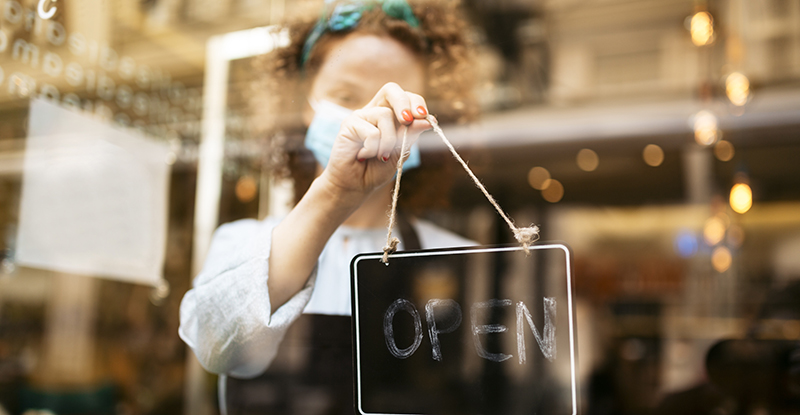
Surviving
Like 79% of small businesses in Canada, Old Salty, a gift shop on Salt Spring Island, was not fully open this past spring. However, when they reopened their doors in the middle of May business quickly ramped up, and by July sales were 75% of the prior year’s and increasingly steadily.
The Canadian Federation of Independent Business’ (CFIB) data for August found this to be the case for almost half of small businesses; monthly revenues were 75% or more of the prior year. And while tourism has been down significantly from previous years, businesses in the area have still been benefiting from steady visitor traffic.
“Although we’re not getting the boaters from the USA we have more visitors than usual from further east in BC and Alberta,” said Karen Stanley, manager of Old Salty. “And they’re spending money. One tourist said that all the money she’d spent shopping during her trip didn’t come close to what she would have spent on a plane ticket.”
Lower revenues at Old Salty were partially offset by lower wage costs. At times staffing was a challenge with employee concerns about exposure to COVID-19. However, limiting the number of customers in the store to comply with COVID-19 protocols meant that they could get by with fewer staff.
Some businesses have added new product lines and expanded their customer base. Thomas FX Group Inc., a North Vancouver-based supplier of speciality products to the movie industry, best known for biodegradable snow and ash products (used in The Revenant, Avengers: Infinity War, Star Trek: Into the Darkness, etc.) became the exclusive distributor of a line of high-intensity UV lights and sanitizing chemicals, and now has added doctors, dentists, and gyms as customers.
Others have survived by changing delivery methods; bookstores offering free delivery, adding online sales, or in the case of restaurants, expanding takeout service.
For those businesses that are surviving, how has their value been impacted? Businesses that are profitable and expected to continue to be so in the foreseeable future are typically valued based on their expected annual cash flow (or net income) divided by an appropriate rate of return.
For example, if expected annual cash flow is $100,000 and an appropriate rate of return is 25%, the value of the business would be $400,000 ($100,000 divided by 25%.) Valuation, however, is an art rather than a science. Although the calculation above appears relatively straightforward, determining the cash flows and rate of return requires careful analysis and judgement.
Pre-COVID-19 expected cash flows were typically based on historical annual results, adjusted for revenues and costs expected to be different in the future. During the current economic uncertainty, we don’t know yet know what “normal” is or will be.
For many businesses the best indicator of post-COVID-19 cash flows may be results from only a few recent months and unproven forecasts. When the risk of achieving expected cash flow is higher, as it would be when there is economic and/or business uncertainty, buyers expect a higher rate of return. If a higher rate of return is used in the calculation above, for example 30% instead of 25%, the value of the business will be lower.
On a positive note, businesses that are surviving demonstrate resiliency and the ability to adapt to changing circumstances. Well-managed businesses are less risky and, therefore, have higher value. If business owners can ride it out to the “new normal” they may not see any decline in the value of their businesses.
Related articles
- Is social media risky business?
- How do you put a price tag on your business? Consider the investment approach
- Gamification: Playing games can help your business strategy
Thriving
Although it’s not a large percentage – 6% according to the CFIB – some small businesses are doing better than before COVID-19. According to Brett Martyniuk, owner of Village Bikes in Richmond B.C., “Business has never been busier.”
At Salt Spring Wild, a cidery serving its own product paired with local gourmet food, production manager Jesse Scott said in August, “We had our best month ever.” Pointing to a large grassy field overlooking a scenic valley set with a dozen picnic tables spaciously apart he added, “It’s the largest patio on Salt Spring Island.”
Buyers of businesses with growth potential are usually willing to accept a lower rate of return, which increases the value they place on the business. If the growth materializes and future cash flows are higher than expected the value is thus realized. Those businesses that are thriving during COVID-19 may well have seen their value rise.
Struggling
Sadly, there are a number of small businesses that have been hard hit by COVID-19. The CFIB survey found that 50% were worried about cash flow, and 23% that they might have to close permanently. The value of a business that is not viable is typically based on net asset value; the amount for which the business assets could be sold, less selling costs, existing liabilities and debt.
The unfortunate double whammy is that due to the economic downturn brought on by COVID-19, the value of those assets may be significantly less than even a few months earlier. But where there is adversity there is also opportunity. For those seeking to buy a business now may be an opportune time as assets or businesses acquired at depressed prices may see the greatest gains.
It is important for business owners to understand how businesses are valued, with advice from valuation experts as needed. Not only will this help with decisions with respect to selling a business or buying one but may also help in determining how to adapt to COVID-19.
Author
Liisa Atva is the author of The Ask: How Much Is a Small Business Worth?. A CPA and CBV, Liisa’s work has appeared in The Globe and Mail, Postmedia publications, Huffington Post, and The Journal of Business Valuation.



